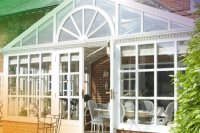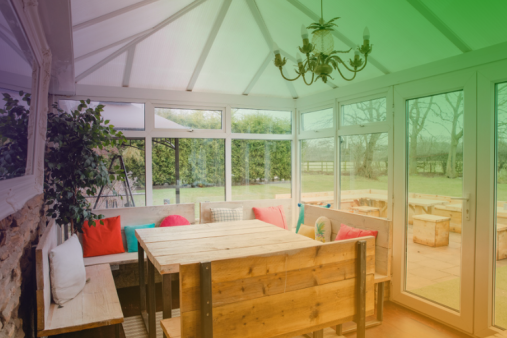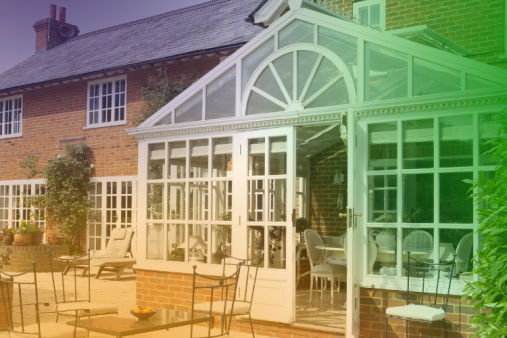Do you work in this trade? Are you a reliable and trustworthy trader looking to generate more work for your business?
Join us todayFind Local Conservatories, Windows & Doors Near You
Why choose a Conservatory for your Home?
Everyone wants more living space, but the difference between a simple extension and a conservatory is that conservatories give you more space to live in, but they also bring the outside in. You feel like you are outdoors whilst being protected from the elements. Conservatories are becoming more popular as they have become more affordable, can add more living space instead of having to move to a new house whilst adding value to your home when you come to sell.
The great thing about conservatories is that they can have many uses from dining rooms, family room or even a sunroom to relax in! Before adding a conservatory, it is wise to speak to your local council to see if you may need planning permission as over 60% of conservatories require planning permission. Contacting your local council and planning office can ease your mind and give you any advice you may need when planning a conservatory.
Generally, if your conservatory is extended to no more than 115% of your house’s total volume, the conservatory edges out from the house by less than 3m and the conservatory does not cover over half of the garden area then you do not need planning permission. Also, if your property is in a conservation area or is classed as a grade II listed building, then there are restrictions and rules on what materials can be used for your conservatory. Conservatories are mainly situated on the back of properties merging into the garden, yet they can also be placed on the side of the house or, very rarely, at the front too!
DIY or Builder
As conservatories are not the cheapest addition to any home, then you may want to consider the option of a DIY self-build kit. Great for limited budgets, these DIY self-build kits are available for the keen DIY-er and come with full instructions. Although this may seem like a great option, constructing the base of the conservatory even with the conservatory kit can be too challenging for most DIY lovers. You could always go 50/50 and get an experienced builder to construct the base or a carpenter to implement the infrastructure then carry on with the rest yourself.
However, if you are looking to use more than one contractor then this can add complications to the project due to differing ideas and possible conflict with no resolutions. Choosing the right builder can make a big project like a conservatory quick and hassle-free. So, it is important to do some research before choosing a contractor to see whether they have a lot of conservatory experience and by checking previous customer reviews, you can judge whether they will be the right one for you!
Prices for Conservatories & Conservatory Installation Cost
As the cost of a conservatory differs depending on the size, additional features and materials used it is difficult to say how much your conservatory will cost. The price of your conservatory will obviously vary depending on the size and design you choose. A smallish, uPVC conservatory will cost from £10,000 and a top of the range orangery made from wood can cost as much as £50,000. With such large sums involved it is very important that you do your homework and get at least three written quotes for the work from trusted local companies. Ask friends and neighbours to recommend someone, or browse through Top Tradespeople for contact details. Be open to suggestions about what sorts of conservatories might be appropriate, but stick to your budget and remember that a very large conservatory may need planning permission.
Step by Step Guide to Buying a Conservatory
Adding a conservatory is one of the UK’s most popular home improvements, and 2.8 million homes have had one built. Relaxing of the planning laws also means that in many cases you can add a conservatory to your home without navigating the lengthy planning process, but the removal of this barrier does not mean that you should just approach the first company you come across. As with any major purchase, there are some key points you have to think about.
What is the new conservatory going to be used for?
A conservatory is only a valuable addition to your home if it has a clear function. Too often, homeowners spend thousands of pounds adding a conservatory only to find they never use it. If you are going to use your conservatory as a dining room, it makes sense to locate it with easy access to the kitchen. If it is to be used as a sitting room, think about how you are going to use blinds to keep the room from overheating in the summer. Having a clear idea about how you are going to use your conservatory will make the decision about which one to buy simpler.
Types of conservatory
There are two main types of conservatory on the market; those made from wood and uPVC ones. In general terms, uPVC conservatories are cheaper than wooden ones, and need less maintenance. Both types of conservatories are available in a wide range of designs, from the traditional to the contemporary. There is no “best” design for conservatory as the choice of conservatory is a matter of personal preference and also often comes down to budget. Always shop around with a few different companies to see what styles and designs are available and which are best suited to your needs.
How long will it take to install a conservatory?
Most conservatories, especially the uPVC ones, come in kit form and are very quick to build. The installers will first lay the foundations in your garden, which will take around a week. Once the foundations are in place, the walls and roof will go up in just a couple of days. A new door between the house and the conservatory will take another day, then you should leave another few days for any electrical work, plastering, fitting of blinds and any decoration or laying flooring.
Double Glazing Specialists
It is no surprise that most of your home’s heat is lost through your windows. But did you know you can minimise heat loss by adding double glazing windows to your home? Installing double glazing keeps your home warmer, quieter, reduces your energy bills and offers reduced condensation for your windows.
Double-glazing creates an insulating barrier by sandwiching two sheets of glass together leaving a gap between the two sheets. It is available in a variety of frame materials and styles. Low emissivity glass, which has a metal oxide coating that lets in light and heat while reducing the amount of heat that may escape, is the most energy-efficient glass for double glazing. The frame can be made of either uPVC, wood, aluminium, or composite. Wooden frames have a lesser environmental impact but require maintenance. Whereas uPVC frames can last for long periods of time.
If you are looking for an eco-friendlier option, aluminium or steel frames can be easily recycled as well as being long-lasting and slim. If you are stuck choosing between aluminium or steel frames then composite frames, which contain an inner timber structure that is covered in aluminium or plastic, would be the perfect choice for your home. If you replace your windows with more energy-efficient double or triple glazing, keep in mind that your replacement frames will be more airtight than your original frames, which means condensation may form due to the reduced ventilation. Instead, choose replacement windows with trickle vents built into the frame to allow a small amount of controlled ventilation.
Can I install Double Glazing on Period Properties or in Conservation Areas?
Many listed buildings and conservation areas can have restrictions on what windows and glazing options are permitted on the property. Before you decide, it is best to find out what choices are available to you by contacting your local council. Modern double glazing must often be made to seem like your building's original windows in order to preserve or enhance the character of the area. According to their grading, listed buildings have very strict restrictions on what can be changed.
A lot of older properties have old sash windows which are usually protected both in its appearance and the materials used. However, new double-glazed windows with timber frames in the same sash style can be found, which many local authorities approve of. Prices are high, but this may be your only choice for getting approval. Secondary glazing or heavy curtains are the alternative options if double glazing is not possible.
How much does Double Glazing cost?
In an average three-bedroom home, a window replacement can cost around £7500, but this can vary due to varying factors including the size and number of windows, the type of glazing you prefer, the glass and materials that are used on the window and frames.
Finding a Double-Glazing Specialist
Finding quotes has never been easier on Top Tradespeople. Simply post your job and we will connect you with up to 3 local window fitters without obligation, and totally free of charge.
In England and Wales, choosing an installer who is registered with one of the official Competent Person schemes will ensure that your windows are installed to the government's standards. If you hire an installer who isn't a member of one of these programmes, you'll need to apply for building control approval before the window can be installed.



